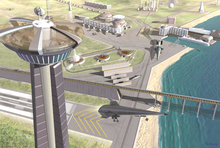
Space trade is all goods and services exchanges that are somehow connected to space travel, exploration and colonization. [1]

Space trade is all goods and services exchanges that are somehow connected to space travel, exploration and colonization. [1]
Several people have considered trade within the Solar System as one of the ways in which the colonization of Mars is both important and can be made self-sufficient. Robert Zubrin, of Lockheed Martin Astronautics, in a paper on the economic viability of colonizing Mars, [2] puts forward interplanetary trade as one way in which a hypothetical Martian colony could become rich, pointing out that the energy relationships between the orbits of Earth, Mars, and the asteroid belt place Mars in a far better position for involvement in any future asteroid mining trade than Earth.
Jim Plaxco, in a paper putting forward the case for colonizing Mars, [3] mentions that Phobos and Deimos can be developed, in the long term, from being short-term testbeds for the techniques of asteroid mining and staging posts for colonization of Mars itself, into key trading posts in interplanetary trade, again because of their favourable position within the Solar System.
It is theorized that if different locations within the Solar System become inhabited by humans, they would need to transport valuable resources between different planets, moons and asteroids. [2] The asteroid belt is theorized to become a source of valuable ores that may develop into industrial asteroid mining infrastructure, whereas Earth may export hi-tech production. [2] The factor of energy-efficiency of interplanetary transportation may become very important to estimate economic value of a trade route.
John Hickman identified the principal obstacle to developing space trade as the distances involved, which will reduce all or nearly all trade to the exchange of intangible goods. That threatens the possibility of conducting business in a genuinely common currency and of enforcing debt agreements incurred by governments. [4]
A 2009 article explored tax implications. [5]

Building high-capacity commercial spaceports may require connection with other modes of transportation, such as railroad or sea, which would make spaceports another dimension of national economy. One analysis of commercial, technical, and logistical concerns for an operating spaceport, formulated by the Spaceport Technology Development Office of NASA, is Vision Spaceport. [6]
.doc download link